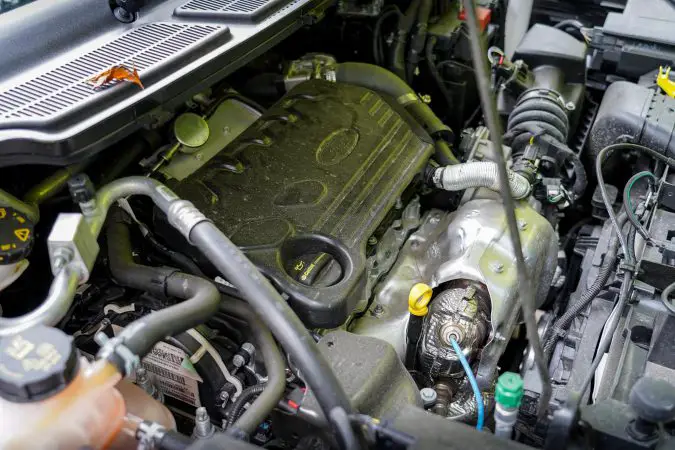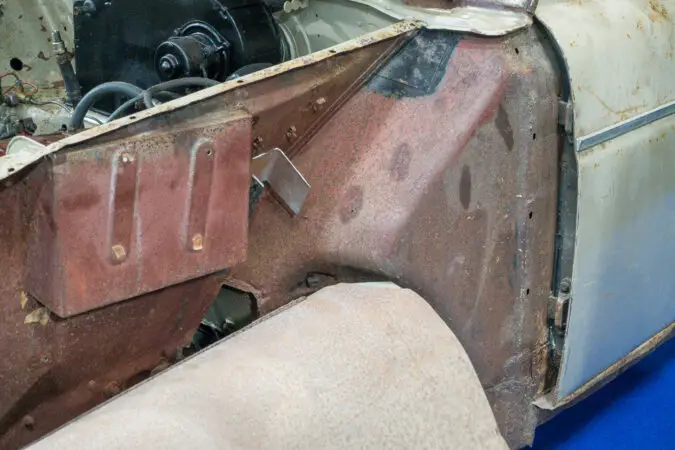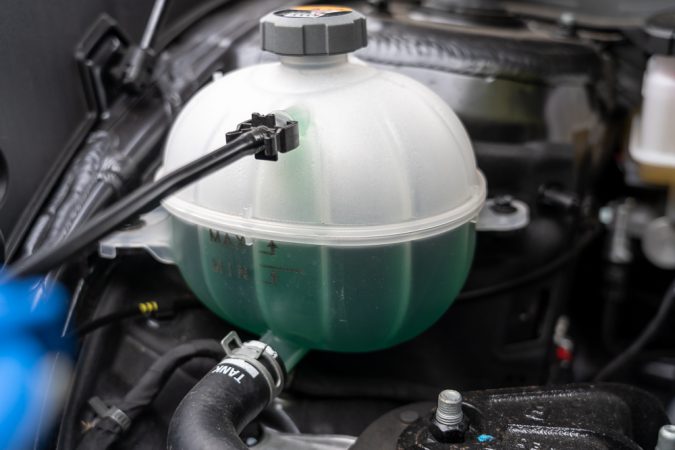A heater core flush is significant for a car whose heater has gone bad or started to malfunction. A heater or the air conditioning of a car is one of the most essential parts of a vehicle, especially when someone is driving the car in extreme weather conditions. So when your heater is throwing out cold air it can be extremely problematic. Driving in the winter with no heater is something you would not want to experience.
A car’s heating system is prone to mechanical failure sometimes, just like the air conditioning system of a car. The reason for a broken heater can usually vary. There are different issues that vary in severity.
A heater core of a car is an essential part of the vehicle’s heating system. It is meant to operate at peak performance without any issues so that it can promptly eliminate the cold air from a car’s cabin. Any problem with the vehicle’s heater core, like clogging, makes the heater of the car ineffective and undermines the ability to control the cabin’s temperature.
- What Is A Heater Core?
- Heater Core Flush Cost
- Heater Core Replacement Cost
- Back Flush Heater Core
- Conclusion
- Frequently Asked Questions
What Is A Heater Core
A heater core is a system that is responsible for radiating heat into a vehicle’s cabin. This heat originates from the engine coolant that flows through this device. The vehicle’s blower motor is responsible for blowing air through the heater core. This displaces the heat through the adjacent duck-work and the vehicle’s cabin gets warmer. This results in a comfortable drive even in the bitter cold with extreme temperatures.
It is important to know that the location of the heater core is usually found in the same spot. This part is usually placed behind the dashboard of a car. It is either placed on the passenger side of the dash or on the center of the dash. The heater core is coated with housing or casing. All of these parts can be found behind the dashboard. However, getting access to it and diagnosing it can be tough.
Bad Heater Core Symptoms
As said before, a clogged heater core can be extremely irritating and problematic. There are several symptoms that can help an individual identify the problem and here is a list of them.
Symptoms can be different from car to car but here are some that are usually common in most cars.
1. No Heat
One of the most common symptoms of a clogged heater core is the fact that there is no heat coming out whatsoever. When the coolant is unable to flow through the heater core of a vehicle, the heating efficiency can be severely diminished. This can result in an extremely uncomfortable drive and make it very difficult to focus on the road.
2. Sweet Smell
Another one of the most common symptoms that come with the is an odd smell inside the cabin. It is possible that there is a leak in the heater system and there is no indication of this leak. Mainly, fogged up windows and windscreen. But yes there will be a fresh melon smell from the vents which might be the indication you need.
This sweet smell usually comes from the car coolant, which signifies a coolant leak into the cabin of your car. If you can smell this fresh melon smell outside as well, you need to check underneath the car to see how much coolant loss is present under it.
3. Coolant Loss
Another symptom of a clogged heater core is the loss of coolant in your vehicle. If you notice that your vehicle is losing too much coolant and you can not figure out the reason, this may be because of a leak in the heater core. Alongside that, if you can not pinpoint the location from where the coolant is leaking, you may have a leak in your heater core.
If this occurs when your system is cold, instead of the fog it will form a puddle. Once you suspect a broken or clogged heater core, you need to check the passenger side of the car, the floor mat might be wet because of the coolant leaking from the heater core.
4. Possible Overheating
Another significant symptom of a clogged heater core is that the engine might start to overheat. This can be extremely problematic as an overheating car can cause several more problems. Other system components can contribute to engine overheating also, so you need to be extremely careful while diagnosing this problem.
Overheating can be extremely serious for the health of your car. An overheating car can cause catastrophic damage to the engine components. So you need to track down the malfunctioning part as soon as possible and replace it.
Always pay attention to your car’s instrument cluster to make sure that your car is not overheating, especially on the highway. Once you experience this problem, you need to park your car on the side of the road and inspect the car. If you can not find the problem you need to reach out to a mechanic.
Causes For A Clogged Heater Core
There are several causes that might cause your heater core to clog. While they might have different origins, all of them lead to the same problem. Hence, here is a list of all the causes of this problem.
1. Rust Build Up
One of the main causes of a clogged or malfunctioning heater core is rust. Rust is like cancer for a car. It causes several problems for your cars. Corrosion of any kind also does a lot of damage to the cooling system of a vehicle. Although, the heat exchangers found within this system are prone to some problems that might cause rust and scale build-up.
This includes the heater core, which has a reputation for getting clogged easily. Rust and scale usually a build-up of this type often results from the overuse of water within a vehicle’s cooling system.
2. Mixing Oil And Coolant
Oil and coolant do not mix together and when they do, they can together form something called a sludge. Sludge is also known as rust and rust in the cooling system can cause the heater core to clog. When this sludge passes through the hoses and pipes, it is circulated around the various parts of the vehicle’s cooling system, including the heater core.
As this circulation continues, it can start clogging the different parts of the cooling system. This does not only mean slowing the coolant passage but also forms rust on the heater core.
3. Stop Leak Products
There are some products on the market called stop leak solutions that promise to fix coolant leaks. Of course, these products sometimes don’t work and a lot of them do not fulfill their promises. Not only do they not keep their promises, but they can have adverse effects on the heater core.
Sometimes these products are responsible for clogging the cooling system of your car. Even the heater core is not immune to this product and the stop leak products can easily spoil it. The radiator can even get clogged, but this usually happens when you use more than the required amount.
Heater Core Flush Cost
A car’s heater cost is one of the most integral parts of the cooling/heating system on a car. This system is responsible for transferring heat into the cabin of your vehicle and keeping you warm on cold days. The heating system of your car efficiently uses the heat produced by your car and reaps the benefits inside the vehicle.
Unfortunately, like any other piece of technology, a heater core can also malfunction or stop working. You may need to get it repaired and get your car shown to a mechanic. Getting a heater core fixed is not very cheap.
The price of repairing the heater core depends upon the make, model, and year of your car. That is a pretty steep price tag so you don’t have to get it replaced unless it is absolutely necessary. However, a heater core flush is relatively cheaper. They can cost an individual anywhere between $100 and $150 to get done. Proper maintenance of the car can also help you skip this problem.
Heater Core Replacement Cost
If the traditional heater core flush does not help in fixing your problem, what you need to do is get the heater core replaced. You are left with no heat and therefore a replacement might be necessary. Unfortunately, this is an expensive position to be in. because the heater’s core is located deep inside the vehicle’s dashboard, and it takes a lot of time and effort to remove it.
This increases the labor cost of just getting the heater core replaced, making the whole process quite expensive. However, the price of the actual part usually varies from car to car. It usually depends upon the make, model, and age of the car. Irrespective of the cost of the parts, a replacement of the heater core should cost you anywhere between $800 to $1100 (this includes the labor cost as well).
Back Flush Heater Core
Back flushing your vehicle’s heater core can be an effective way to fix the heating problem faced by your vehicle. Flushing your vehicle’s core can help you get rid of the heating problem faced by your vehicle. Therefore here is a list of everything you need to back flush your heater core. Alongside that, there is also a step-by-step explanation of how to go about it.
Everything You Need To Back Flush Your Heater Core
The tools that you might need to back flush your heater core defer from car to car. It usually depends upon the make and model of your car. However, in general, you will need:
- A 50/50 pre-mixed coolant (you need to consult your owner’s manual to know the correct type of coolant that should be put in your vehicle)
- An air compressor (recommended)
- A bucket
- Clear tubing that’s the same diameter as the heater hoses
- Cooling system vacuum fill tool (recommended)
- Fluid catch pan
- Fluid container
- Garden hose adapter fitting
- Infrared thermometer
- Jack and jack stands
- Pliers
- Screwdrivers
- Repair manual or access to a repair database (recommended)
- Safety glasses
- Wheel chocks
Heater Core Back-Flush Instructions
Once you have collected all the things required for back-flushing the heater core, here are certain steps that you need to follow to carry out this process without any problems. Before getting into the specifics you have to remember that all cars are different. The information provided below is generic and only for educational purposes.
It is always a good idea to refer to the manual or show your car to a professional. Though the following steps will give you an idea of what to do or expect from a heater core back-flush.
Step 1: Prepare Your Vehicle
Before getting into anything you need to ensure your own safety as well. You need to get safety glasses before you start this process. You also need to check if the engine is off and cool as hot coolant can cause some serious injury. Hence make sure that the engine is cool.
Once you have taken the security measures safely raise and support the vehicle using a jack and jack stand. You also need to put your parking brake on to stop the rear wheels. Place the fluid catch pan under the vehicle to avoid spillage. Remove the radiator cap and your car is ready for a coolant drain.
You can drain the coolant from your car by either disconnecting the lower radiator hose or by simply opening the radiator drain petcock. Disconnecting the lower radiator hose is easier as the petcock is extremely delicate and can sustain damage.
Make sure that the fluid catch pan is right under the hose to avoid spillage. To loosen the hose clamp, you need to use a pair of pliers or a screwdriver (this usually depends upon the design of the clamp). After getting rid of the clamps, allow the coolant to drain into the fluid catch pan.
Once they have drained the radiator you need to reinstall the radiator hose and titan the clamp
Connect an adaptor fitting to your garden hose which further will be connected to the clear tubing. Locate the heater hose and figure out which hose is the inlet and outlet.
Step 2: Back-Flush The Heater Core
What you need to do is use a pair of pliers or a screwdriver to lose the hose clamps on both the heater hoses. Disconnect the heater hoses one at a time from the heater core. This will allow the rest of the coolant to drain from the heater core and into the fluid catch pan.
Connect the clear tubing attached to the garden hose to the heater core’s outlet. Connect another piece of the clear tube to the inlet of the heater core and place the other end of this tube into a bucket. Now you can turn on the garden hose.
Be sure to control the pressure of the water coming out of the garden hose. Too much pressure can end up damaging your vehicle. You need to let the water flow through the cooling/heating system till you can see clear water in the bucket.
Once this is done, most of the work is complete. You now need to remove the clear tubing from the heater core’s inlet and outlet connections.
It is now time to reinstall all the heater hoses and clamps back into place. And the fluid catch pan can be removed too.
Step 3: Refill The Cooling System
Once the heater core is flushed, safely remove the jack stands and lower your vehicle. Once your vehicle is back on the ground, bleed the whole cooling system with air. To do this, you need to follow the instructions that come along with the cooling system vacuum tool. Connect this tool to the air compressor of your car and let it work its magic.
Simultaneously keep refilling your vehicle with new coolant. Follow the instructions that come with the tool to refill your car with the 50/50 mix of the fresh coolant. Top off the coolant as needed and reinstall the cap of the radiator.
You need to make sure that your vehicle is not overheating by starting your engine and checking the temperature gauge. You need to do this till the engine reaches the correct temperature and the cooling fan turns on.
Pour all the old coolant and slush from the pan into a fluid bag and dispose of it responsibly. Make sure to clean up any coolant residue as coolant can be extremely lethal if consumed. The smell of the coolant also attracts animals.
You need to go online and look for a way to dispose of this waste properly. It is illegal to pour coolant down the drain so be careful. Usually, people get rid of this waste at a landfill that accepts hazardous waste.
After driving your car for a couple of days, you need to recheck your coolant levels. If there is a drop in the coolant level make sure to top it off as needed.
Conclusion
Driving in the cold without a heater can be extremely difficult. Especially if you live in a place with extreme temperatures. If your car’s heater is also not working you need to check the heater core of the car. you need to get your vehicle checked and fixed as soon as possible because a clogged heater core can cause more damage than good later on.
Heater Core Facts:
- A vehicle’s heating system is prone to mechanical failure, and a clogged heater core is a prevalent and aggravating issue that can undermine the heating system’s ability to regulate internal temperatures.
- A heater core is a heat exchanger that radiates heat into a vehicle’s cabin, and it must operate unabated and at peak efficiency to promptly eliminate the chill from a vehicle’s cabin.
- Several symptoms often accompany the presence of a clog within a vehicle’s heater core, including a lack of heat, subpar heat in extreme cold, and possible overheating when combined with additional issues.
- Rust/scale build-up, mixing of oil/coolant, and use of a stop leak product are several of the most common causes of a clogged heater core.
- A clogged heater core can be flushed in some instances, costing somewhere in the neighborhood of $75-$100, while heater core replacement costs approximately $750-$1,100.
- The exact price of heater core replacement can vary greatly from one model of vehicle to the next, and most shops charge for the number of labor hours specified by a vehicle’s manufacturer when completing repairs.
- The heater core itself is mounted deep beneath a vehicle’s dash, in close relation to the interior side of the firewall, and heater core-related issues are typically diagnosed by analyzing one or more symptoms associated with the failure at hand.
- Coolant lines are affixed at inlet and outlet junctions at a vehicle’s firewall, courtesy of hose clamps or quick-connect unions.
- Some vehicles regulate the flow of coolant through these hoses, by way of a specialty heater control valve, typically controlled by vacuum or electrical means, and actuates in response to control head input.
- Corrosion of any type is extremely detrimental to a vehicle’s cooling system as a whole, especially heat exchangers, such as the heater core, which tends to clog quite easily, and this often results from the prolonged use of water within a vehicle’s cooling system.
Frequently Asked Questions
Here is a list of common questions people have with a heater core flush.
What Is A Heater Core
A heater core is like a smaller version of the radiator. A radiator is used to cool the motor of the car, instead, the heater core uses the heat from the coolant to keep the cabin of a car warm. It is a piece of technology that diverted the coolant from the rest of the car’s cooling system to keep the interior warm.
How To Unclog Heater Core
Usually, it is possible to unclog a heater’s core by simply just using a water hose or an air pressure kit. But many modern heater cores have plastic lines and tanks so this can be risky for your car. Do not exceed the pressure that is given on the radiator cap as it can damage your cooling system. Another possibility of this problem is that the exterior fins of the heater core are blocked by some debris sucked in by the air filter. Cleaning these fins might help you get over this problem.
How To Tell Inlet And Outlet On Heater Core
There are three main ways to make out the difference between the inlet and outlet of the heater core. The first one is that the inlet usually has a piece of technology called the heater control valve. This is responsible for controlling the steam released by the coolant. Another way to tell the difference is that when the heater is turned on, the hotter of the two hoses will be the outlet. The third way to check which is the inlet and outlet is to follow both the hoses. One of them will connect to a small metal pipe called the water pipe. The other pipe is connected to the engine and is placed horizontally. The pipe connected to the engine is the outlet.
Where Is Heater Core Located
A heater core is usually placed under the dashboard of your vehicle. It is enclosed by the whole ventilation system and therefore is extremely hard to reach. Getting to the heater core requires disassembling a large part of the dashboard and therefore it is extremely labor intensive and expensive.
How Long Does It Take To Replace A Heater Core
The time to replace a heater core usually depends on the age and condition of your vehicle. Replacing a heater core can take anywhere from 3 to 8 hours depending on the car. If you decide to do this as our first DIY project it can take a significant amount of time.
How Much Does It Cost To Flush A Heater Core
Flushing a heater core is not as expensive as replacing it. A heater core backflush can cost you around $100 to $200 depending upon the time and labor that was used to carry out the whole process. On the other hand, a heater core replacement can cost anywhere between $800 to $1000.




